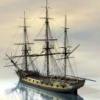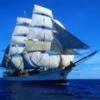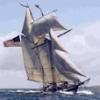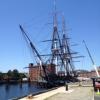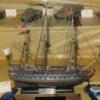-
Posts
153 -
Joined
-
Last visited
Reputation Activity
-
 clloyd reacted to Remcohe in HMS Kingfisher 1770 by Remcohe - 1/48 - English 14-Gun Sloop - POF
clloyd reacted to Remcohe in HMS Kingfisher 1770 by Remcohe - 1/48 - English 14-Gun Sloop - POF
Thanks for the nice compliments.
Sure, if I can hire you to do the drafting of the furniture, as I love your drawings. So just send your idea's and we'll make it a joint effort.
The upper half of the cupboard as two features, one shelf for pots and one to hold plates, I got the idea of some pictures I found of galleys.
Remco
-
 clloyd reacted to Erebus and Terror in HMS Terror by Erebus and Terror - FINISHED - Scale 1:48 - POB - as fitted for polar service in 1845
clloyd reacted to Erebus and Terror in HMS Terror by Erebus and Terror - FINISHED - Scale 1:48 - POB - as fitted for polar service in 1845
OLIVER LANG’S STERN
In February 1845, Oliver Lang, Master Shipwright at Woolwich, faced a daunting challenge. The Admiralty, under pressure from Parry, had decided to outfit HMS Erebus and Terror for auxiliary screw propulsion, powered by small passenger locomotives.
Screw propulsion was in its infancy and contemporary designs, based on patents filed by Francis Pettit Smith and others, called for the placement of the propeller opening in the deadwood of a steam powered vessel (Bourne 1855:28). However, applying such a modification to polar vessels would critically weaken the stern, and Lang knew from the Terror’s first arctic expedition that even the most robust sternpost was severely vulnerable when overwintering in sea ice. How could he protect the ship’s stern from the pack when a gaping hole had to be cut in the deadwood for the propeller?
His solution appears in a plan dated March 17th, 1845, which was subsequently transcribed onto the 1836/37 profile plan for HMS Terror. Instead of altering the ship’s existing stern, Lang simply extended the stern of the ship aft by adding a new keel section, onto which a new rudderpost and aperture for the propeller were attached. The 1836/37 plans seem to show that Terror’s original sternpost had been modified for Back’s voyage, but the 1845 annotations clearly indicate that Lang reconstructed it to the same configuration used in Terror’s original design (alternately, it is possible that Terror’s stern was not modified in 1836 as planned).
Lang’s 1845 design called for a triangular piece of wood to be bolted to the original sternpost, creating a vertical face for the propeller aperture. The new rudderpost and the angled fitting were both tenoned into the keel extension, as indicated by the presence of horizontal bolts on a contemporary model of the design. The entire structure was then bolted to a massive u-shaped “staple knee”, made from 3.5 inch thick iron, which was the same length as the propeller opening.
Lang next turned to the problem of protecting the new rudderpost and propeller aperture from ice damage. He settled on a well system which could be used to ship and unship the propeller, similar to a design patented by Joseph Taylor in 1838 (Bourne 1855:32). However, Lang’s system included a new innovation; when the propeller was unshipped, the well would be filled with a series of stacking wooden and steel chocks. The chocks were shaped to match the dimensions of the new rudder post and deadwood and would completely fill the well, thus reinforcing the rudderpost against forces exerted by the ice.
Taylor’s patent described that the propeller could be shipped via “vertical grooves cut in the true and false stern posts … in which frame the propeller is placed” (Bourne 1855:32). However, the use of reinforcing chocks required that this system be modified. Lang replaced the grooves in the stern and false stern with robust iron rails which themselves had a vertical slot running much of their length. The protruding rails were necessary to secure the chocks in the propeller well and needed to be very strong to endure the pressures of pack ice (I’ll present more on the configuration of this rail system and the propeller in a subsequent post).
While we may never know how Lang’s chock system faired after two years in the grinding pack off King William Island, we can surmise that it must have worked relatively well because the Terror survived its first winter at Beechey Island in sailing condition. Further, we know that the same chock system was installed on the Intrepid and Pioneer (Anonymous 1850:8), steam tenders used in the Franklin search effort, and that both ships survived multiple winters in sea ice before being abandoned in relatively seaworthy condition.
Scantlings for Terror’s Sternpost and Rudderpost
Sternpost
Sided
At Head = 13 and ½ inches
At Heel = 10 and ¾ inches
Moulded depth = 17 and ½ inches
Rudderpost
Sided
At Head = 13 and ½ inches
At Heel = 10 and ¾ inches
Moulded depth = 13 and ½ inches
References:
Anonymous
1850 Naval Intelligence — The Arctic Expedition. The Times. Monday , 6th May, pg 8.
Bourne, John
1855 A Treatise on the Screw Propeller with Various Suggestions for Improvement. Longman, Brown, Green, and Longmans, London.
Cut stern pieces prior to assembly.
Assembled stern architecture (significant iron work has yet to be installed, and
the temporary basswood piece is to provide rigidity until the propeller well is completed).
Detail of keel piece and opening for the staple knee.
Aft view of the unique rudderpost joint with the keel.
Another view of Lang's design.
Sanding two of the sternpost bolsters to match the aft station
(the bolsters provide width needed for the propeller well).
Detail after sanding.
Comparing the bolster to the body plan.
Completed rudderpost and sternpost bolsters.
Two of the bolsters in place, showing how they add width to the stern to accommodate
the propeller well (these aren't glued and cannot be until the bulkhead is attached).
Current progress on the stern, keel, and stem.
-
 clloyd reacted to Remcohe in HMS Kingfisher 1770 by Remcohe - 1/48 - English 14-Gun Sloop - POF
clloyd reacted to Remcohe in HMS Kingfisher 1770 by Remcohe - 1/48 - English 14-Gun Sloop - POF
Thanks guys. Druxey, actually the drawers are made with half blind dovetails
For the utensils I thought to just borrow the admiral's but somehow they don't fit.....
Well a scaled down version then.... I leave it up to you to guess how I made these...
Enough playing around let's get back to the serious stuff (but maybe next build a doll house?)
Remco
-
 clloyd reacted to Remcohe in HMS Kingfisher 1770 by Remcohe - 1/48 - English 14-Gun Sloop - POF
clloyd reacted to Remcohe in HMS Kingfisher 1770 by Remcohe - 1/48 - English 14-Gun Sloop - POF
Interesting discussion, unfortunately my NMM plans don't show the position of the lanterns.
Meanwhile I've made some storage space for the galley, I wasn't pleased with MKI
so I build MKII with thinner hinges and a working drawer. Behind it I'll make an open cupboard.
Remco
-
 clloyd reacted to Rustyj in Bomb Vessel Granado by Rustyj - FINISHED - 1:24 - cross-section
clloyd reacted to Rustyj in Bomb Vessel Granado by Rustyj - FINISHED - 1:24 - cross-section
Hi All, It's been a bit since my last post. Life, sub zero temperatures and feet of snow
have all conspired to slow me down. Well the lathe has arrived and the learning curve
is steep but the Sherline is a truly fine lathe. Thanks all for talking me into it.
I tinkered around turning some scraps trying to figure out what I was doing and one
mortar has been made. More coats of paint are needed and then it will be mounted
to the carriage.
The new carriages have also been made. Here is a comparison between the two.
After that the fun continues when I have to try and figure out how to turn two
cannon barrels. Well not only do I have to make two but for some reason they
have to match. Hmmmmm...........
-
 clloyd got a reaction from JPZ66 in Licorne 1755 by mtaylor - 3/16" scale - French Frigate - from Hahn plans - Version 2.0 - TERMINATED
clloyd got a reaction from JPZ66 in Licorne 1755 by mtaylor - 3/16" scale - French Frigate - from Hahn plans - Version 2.0 - TERMINATED
No no no...
one doesn't need a lathe to make masts. The masts I've made using just a a chisel and sandpaper are better looking than the turned ones.
Space issues though - I'll give you that one
Colin
-
 clloyd reacted to JPZ66 in casting metal parts including cannon
clloyd reacted to JPZ66 in casting metal parts including cannon
Hi All,
Colin answered that pretty well. The quality of the master is very important......especially in resin casting, what you see is what you get.
You choose an appropriate resin to cast with and along with well made molds ( a big key here ), you get your castings.
Metal is a bit more involved..... Typically metal castings are done on centrifugal casting machines, using vulcanized rubber molds. The caster must have a good understanding of many factors that come into play.
White Metal is a generic term. There are many formulas to be had here, depending upon the mix. Tin, Antimony, and copper are the primary metals used in this mix, and the casting properties can be affected by the ratios of each metal used. Furthermore, the purity, the temperature, the spin speed, flow distance, part orientation and plate pressure of the mold clamps can all play a part. Most casters develop their own feel for it and manage to come to workable settings for the type of casting they do. It is part science, and part experience. Play with any of those variables and you can have any number of quality issues....mis-cast, porosity, drossy or dirty parts, brittle or crystalized looking parts, etc. Get them all right and you have clean, crisp, dense and well structured parts.
Trust me, there is a learning curve to production white metal casting !
As for the finished items and how do different materials compare, if the quality of the castings are equal - be they resin, metal or some other material, well painted and detailed parts will show no difference. For the hobby modeler who wishes to make castings, I would recommend RTV silicone molds and a low odor casting polyurethane resin.
- Joe
-
 clloyd got a reaction from dafi in Batavia shipwreck photos
clloyd got a reaction from dafi in Batavia shipwreck photos
Hi All
just uploaded a gallery of photos of the Batavia original timbers that are on display in the Shipwreck museum in Fremantle. I took these about 18mo ago while out there, and figured they would be a useful resource for anyone interested in VOC ships. Batavia dates from 1628.
There are some interesting features and a couple of the cannon she was carrying as well.
http://modelshipworld.com/index.php?/gallery/album/648-batavia-shipwreck-wa-museum-shipwreck-galleries-fremantle/
Imgages are HD size - which kept them well inside the upload size limit. If anyone wants full size (18M pixel) of any pic PM and I'll forward it to you.
Colin
-
 clloyd got a reaction from Elmer Cornish in HMS Pandora 1779 by clloyd - Scale 1/64 - POB - 1790 configuration
clloyd got a reaction from Elmer Cornish in HMS Pandora 1779 by clloyd - Scale 1/64 - POB - 1790 configuration
To finish, I was able to figure a way to light the mast to give some detail.
Pics are large.
Things to note.
The heads are stained, but the stain and glue don't fully agree, so they will be painted later. Prestaining should mean I need only one or two thin coats.
The bowsprit shot gives a good indication of how nicely lemonwood finishes up (it's still raw wood there)
The mizzen mast seems to have been occupied by rigging spiders - their work needs to improve.
Enjoy.
Current tasks:
Making sawdust: Portlids and sheaves in the hull.
Hurting brain: quarter gallery construction.
Colin
-
 clloyd got a reaction from Elmer Cornish in HMS Pandora 1779 by clloyd - Scale 1/64 - POB - 1790 configuration
clloyd got a reaction from Elmer Cornish in HMS Pandora 1779 by clloyd - Scale 1/64 - POB - 1790 configuration
Lower Mast Continued...
Fish
Running down the front of the mast we had the fish. This again was rectangular stock, but this time I did shape the inner surface, then glued it to the front of the mast, then the external surface sanded round.
Examining Steel - I noted that before the cheeks were added there were iron bands to support the central spindle of a made mast. These were done in paper, and do not actually go under my cheeks or fish - they are just tiny squares, with matching bands on the rear of the mast.
Wolding, Trestletrees and crosstrees.
Once all that was sorted the wolding was added, with paper again serving for the wooden bands above and below.
I don't have any photos of building the trestletrees and crosstrees, so they are presented mostly built. The foremast not complete since I need an item of served rigging in place before permanantly fixing them.
Bowsprit
Shaped in the same manner as the lower masts. Constructing the bees was an interesting and rewarding task - I was able to actually install sheves here.
Test fitting....
-
 clloyd got a reaction from Elmer Cornish in HMS Pandora 1779 by clloyd - Scale 1/64 - POB - 1790 configuration
clloyd got a reaction from Elmer Cornish in HMS Pandora 1779 by clloyd - Scale 1/64 - POB - 1790 configuration
This will mark the end of the historical photos - I've pretty much exhausted the supply of what is sitting around on my computer, and brings us mostly up to date.
First a couple of quick catchup photos:
Trial cannon - allowing me to test fit everything.
Current state of the rudder.
Lower Masts:
As mentioned before I chose to make the lower masts at this stage - to ensure that they fit and were straight while I could still get into the bowels of the ship if needed.
The construction process is essentially similar to what is outlined in TFFM:IV, with some allowances for building at 2/3 the scale.
Central spindle
Lemonwood Blanks were cut to length (not the full length on the masts, since mine terminate in the middle of the false keel), and maximum diameter of each mast. On opposing sides, the centreline, cardinal points along the length (deck, quarters, head) and diameters were marked.
These references were used to chisel/plane a taper into the mast...
Then the process was repeated to taper the other two sides. Once all four sides were tapered, then the sides were marked out for octagonals and the mast shaped into an octagonal.
This was then Clamped in a vice (baswood in the jaws to protect and sanded round.
resulting in this....
Cheeks
After all that work we then cut a chunk of it away... In full size practice the mast cheeks were shaped around the mast, Hard to do at scale so we cheat by cutting the mast and attaching the cheek to a flat surface.
Marking out the angles through the head and the end point of the cheeks on the mast spindle...
These define the line that we run the mast through the tablesaw (triple check and deep breath time...)
The cheeks themselves are rectangular stock, rounded in the same way as the mast, with trangular notches ready to accept the bibs.
Here is a mast, slimmed down with it's cheeks with bibs attached (with their slight outflare)
When you glue that all together you get this... The bands on the head are paper.
-
 clloyd got a reaction from Elmer Cornish in HMS Pandora 1779 by clloyd - Scale 1/64 - POB - 1790 configuration
clloyd got a reaction from Elmer Cornish in HMS Pandora 1779 by clloyd - Scale 1/64 - POB - 1790 configuration
Interior Fit:
While also working on the exterior some of the main deck components have been assembled.
Capstan Step,
I think this was Holly - It's been oiled so looks different in the last photos to the deck planking. It's 3 individual pieces slotted together.
Gratings and Coamings:
Gratings were manufactured from Boxwood, one side notched, with straight pieces glued across the notches. I made larger then cut them down to size. The coamings are of jarrah, beveled, rounded off, cambered, and I used a camber on the inner face to force the gratings to bend a little to reduce the sanding involved in shaping them.
Ladders:
jarrah and holly, coamings made the same way.
Mainmast partners:
Made from Holly. This was one of the interesting components to build, as the plans disagree on different views. Some views they are notched to allow for the outboard leg of the chainpump to pass by, in other views it clears the partners and no notch is needed. Building the chainpumps showed the latter was correct.
When you put them all together...
You can see also in this the riding bitts have been completed and are in place as well. Deck planking between the structures has started there as well.
Colin
-
 clloyd got a reaction from Elmer Cornish in HMS Pandora 1779 by clloyd - Scale 1/64 - POB - 1790 configuration
clloyd got a reaction from Elmer Cornish in HMS Pandora 1779 by clloyd - Scale 1/64 - POB - 1790 configuration
Continuing on.
Getting there.
I can't find any pics of the lower hull planking in progress apart from this .
Coppering:
Coppering is done with individual plates, prestamped with a nail pattern. I bought 7/16" (I think) adhesive copper, and cut into 3/4" lengths. I was really pleased to find a width of copper that was exactly right at my scale. For the whole hull I used an entire 32yd roll with about 100 to spare.
I tried an experiment to get the nail pattern right. I took a 2mm thick peice of strip, glued a nail pattern on and drilled holes in the appropriate place. Then I used acupuncture needles through the holes and on 2 edges. The AP needles are 0.25mm diameter, so are actually pretty close in scale to the nails. The nail pattern I produced was like this...
Pros: good pattern that burnishes down beautifully.
Cons: Fiddly. There are 40 odd needles that need to be in place, even depth, glued down. They are smaller than the smallest holes you can easily drill. They are designed to pierce skin easily. They do blunt, and bend. To make the press easier to hold, I created a handle out of scuply around the rear side of the needles.
I got delayed in coppering so the first few plates went on about 6mo before the rest. I decided to take a pic to show people what you can expect from copper that has been handled, and exposed to air.
Progress....
Just visible in the last pic is the batten along the top edge of the copper.
Colin
-
 clloyd got a reaction from avsjerome2003 in Best airbrush for use on acrylic based paints
clloyd got a reaction from avsjerome2003 in Best airbrush for use on acrylic based paints
As a note to what has been said there.
Single action generally goes hand in hand with bottom (suction) feed. This is good for large volumes, but sacrifices precision control. You press down the button and you get air+paint. Great for covering large areas, not so great if you want to do anything small or precise, as you always get the same amount of paint coming out.
Double action lets you control both when you get air, and how much paint you are introducing into the airstream. A lot of double action brushes are gravity fed, and usually that means paint cups of 5ml or less. However you can get bottom fed DA brushes.
If you imagine doing more with your brush then investing in a better brush earlier is worth while. You can learn on a good brush, but a cheapo brush will need to be replaced if you end up wanting to do more.
Colin (who owns a Harder & Steinbeck Infinity)
-
 clloyd got a reaction from CaptainSteve in Batavia shipwreck photos
clloyd got a reaction from CaptainSteve in Batavia shipwreck photos
Hi All
just uploaded a gallery of photos of the Batavia original timbers that are on display in the Shipwreck museum in Fremantle. I took these about 18mo ago while out there, and figured they would be a useful resource for anyone interested in VOC ships. Batavia dates from 1628.
There are some interesting features and a couple of the cannon she was carrying as well.
http://modelshipworld.com/index.php?/gallery/album/648-batavia-shipwreck-wa-museum-shipwreck-galleries-fremantle/
Imgages are HD size - which kept them well inside the upload size limit. If anyone wants full size (18M pixel) of any pic PM and I'll forward it to you.
Colin
-
 clloyd got a reaction from mtaylor in Licorne 1755 by mtaylor - 3/16" scale - French Frigate - from Hahn plans - Version 2.0 - TERMINATED
clloyd got a reaction from mtaylor in Licorne 1755 by mtaylor - 3/16" scale - French Frigate - from Hahn plans - Version 2.0 - TERMINATED
No no no...
one doesn't need a lathe to make masts. The masts I've made using just a a chisel and sandpaper are better looking than the turned ones.
Space issues though - I'll give you that one
Colin
-
 clloyd got a reaction from druxey in Positioning Cathead
clloyd got a reaction from druxey in Positioning Cathead
Which you won't do if you bring out the rotary tool. This is an operation to which the rotary tool is not suited. It can take too much off too easily.
Colin
-
 clloyd got a reaction from WackoWolf in Positioning Cathead
clloyd got a reaction from WackoWolf in Positioning Cathead
Which you won't do if you bring out the rotary tool. This is an operation to which the rotary tool is not suited. It can take too much off too easily.
Colin
-
 clloyd got a reaction from Jaxboat in Batavia shipwreck photos
clloyd got a reaction from Jaxboat in Batavia shipwreck photos
John, thanks - your recollection is correct - it is quite dim and absolutely pushing the limits of my camera.
Druxley, Marc - I figured the general interest in any contemporary evidence amongst the members of this site would make things like that (which are quite different) interesting and hopefully useful.
Mark - I got stuck in a "lots of pics" = "gallery" mindset. I checked with chuck and he was ok, but you are absolutely right - that forum is probably a better place. Will shift things around when I get more than 5 mins to myself.
Colin
-
 clloyd reacted to AlexBaranov in HMS Cumberland 1774 by AlexBaranov - FINISHED - 1:36
clloyd reacted to AlexBaranov in HMS Cumberland 1774 by AlexBaranov - FINISHED - 1:36
Neptune, Poseidon, Nij
-
 clloyd reacted to Dan Vadas in HMS Vulture 1776 by Dan Vadas - FINISHED - 1:48 scale - 16-gun Swan-class sloop from TFFM plans
clloyd reacted to Dan Vadas in HMS Vulture 1776 by Dan Vadas - FINISHED - 1:48 scale - 16-gun Swan-class sloop from TFFM plans
Thank you very much John, Colin, Doris and Popeye .
Fitting the Channels perfectly horizontally was accomplished by the use of a couple of specially made "jigs" that sit on the planksheers from one side to the other. Masking tape and clamps hold the jigs firmly in position. The leg glued to the underneath of the horizontal member was measured at the inboard edge and cut square.
Danny
-
 clloyd got a reaction from gjdale in HMS Victory by gjdale - FINISHED - Mamoli - Scale 1:90
clloyd got a reaction from gjdale in HMS Victory by gjdale - FINISHED - Mamoli - Scale 1:90
Damn - I forgot that you'd done that, and it wasn't obvious in the more horizontal photos. At least Grant has full info to make his decision from.
Colin
-
 clloyd reacted to Dan Vadas in HMS Victory by gjdale - FINISHED - Mamoli - Scale 1:90
clloyd reacted to Dan Vadas in HMS Victory by gjdale - FINISHED - Mamoli - Scale 1:90
Colin, they are .
Danny
-
 clloyd got a reaction from ScottRC in Painting the 1/180 scale HMS Victory
clloyd got a reaction from ScottRC in Painting the 1/180 scale HMS Victory
Shouldn't be an issue over primer. Any acrylic paint will sit over primer well enough.
They will take some experimenting with thinning, as I'm not sure they were designed to be airbrushed, and I've no idea what particle size in the pigment would be.
Colin
-
 clloyd got a reaction from gjdale in HMS Victory by gjdale - FINISHED - Mamoli - Scale 1:90
clloyd got a reaction from gjdale in HMS Victory by gjdale - FINISHED - Mamoli - Scale 1:90
When I did bounty I did one way one side, the other on the other side - to show potentially that one side of the ship was being worked.
Danny's idea is useful too. (though possibly if they were going to lift boats the yards may have been braced around a bit to clear the shrouds better and produce better angles of force).
Colin


